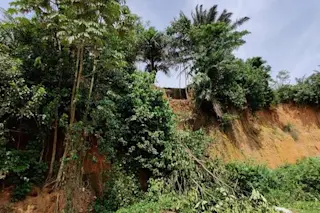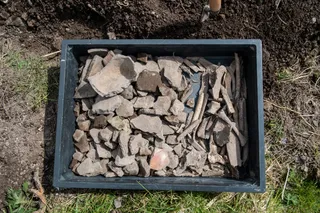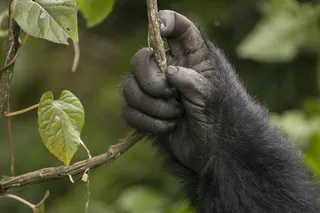In the late ‘80s, a team of Soviet and West African archaeologists discovered an African rainforest site that had the potential to rewrite at least a chapter of human evolutionary history. Artifacts encased in several layers of sediment hinted that some early humans had settled and thrived there, during a time when it was thought that they evolved primarily on savannas. Almost nobody paid attention.
There were three reasons. First, the group published its findings in Russian, which relatively few scientists outside the Soviet Union could read. Second, West Africa was then not considered a major scene in human evolution. And third, the team lacked the technological tools to accurately date the tools, plant remains, and layers of dirt.
Over 30 years later, a new group — guided by one of the original team members — returned. This time they showed humans had lived in this rainforest about 150,000 years ago, according to an article in Nature. That’s nearly 10 times longer than previous evidence for African rainforest occupation, and more than twice as long as the next most recent human rainforest habitat globally, found in Southeast Asia.
Multiple Habitats for Early Humans
The implications go deeper than just changing some dates. The finding lends credence to a theory that humans were evolving in multiple, diverse habitats at the same time.
“Knowing that groups of hunter-gatherers already lived in radically different habitats and ecosystems this far back tells us that ecosystem diversification lies close to the root of our species, and that this ability probably modulated patterns of contact and genetic exchanges between different groups of people,” says Eleanor Scerri, a professor at the Max Planck Institute of Geoanthropology and an author of the study.
Scerri has long rejected the idea that humans emerged from a single population and region. She had a hunch that human evolution wasn’t just what she calls a “Savanah Process.” Picking this particular site allowed her to address two hypotheses.
Read More: How Early Humans Adapted to Harsh Desert Climates Over a Million Years Ago
The Anyama Site
Two key factors made the Anyama site a perfect natural laboratory. First, climate data and models indicated that the area had always been a rainforest. Second, the earlier excavation revealed the site to be deeply stratified — in other words, many layers of soil held a variety of clues about how the area was lived in over time.
It also didn’t hurt that much of the digging had already been done, and that one of the trench’s original excavators — Francois Yodé Guédé, a West African archeologist — could lead them to it.
“The original trench was easily visible once we were taken to the location by Professor Guédé,” says Scerri,. “That said, their excavation and sedimentological work was so good, our work almost feels like an extension of theirs, a final chapter, so to speak.”
Read More: Two Different Early Human Species Walked the Same Lake 1.5 Million Years Ago
Humans in the Rain Forest
Once there, along with stone tools, they found numerous pieces of plants and stones in layers representing different time periods. They were fortunate that the trench had already been dug and only needed minimal work to extract samples, because as soon as they arrived, they realized they were in a race against time.
The field team had arrived at the site just as the COVID-19 pandemic was spreading and had to evacuate within a week. They secured as many samples as they could and scrambled to formulate a plan to get out.
“They were on the last flight out of Abidjan before the airport shut down,” says Scerri. “The site was subsequently destroyed before we could get back to it. Being able to close the site’s story with such aplomb is a gift, given the circumstances.”
Article Sources
Our writers at Discovermagazine.com use peer-reviewed studies and high-quality sources for our articles, and our editors review for scientific accuracy and editorial standards. Review the sources used below for this article:














